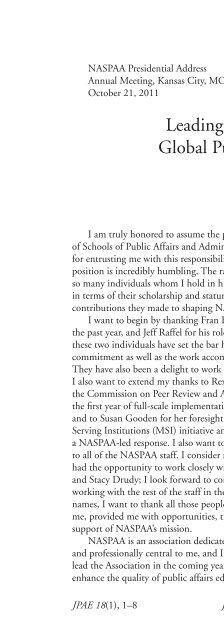WINTER 2012 - National Association of Schools of Public Affairs and ...
WINTER 2012 - National Association of Schools of Public Affairs and ...
WINTER 2012 - National Association of Schools of Public Affairs and ...
Create successful ePaper yourself
Turn your PDF publications into a flip-book with our unique Google optimized e-Paper software.
Nadia Rubaii<br />
competencies such as those being developed for Local Government Management<br />
in collaboration with ICMA, <strong>and</strong> those for Budgeting <strong>and</strong> Finance. The<br />
Nonpr<strong>of</strong>it Section has been busy identifying competencies, <strong>and</strong> I hope that in<br />
the coming year they will transition to operational definitions <strong>and</strong> assessment<br />
measures; I have asked the Health Care Section to begin that process. By the<br />
<strong>2012</strong> conference, we should be ready to have an Accreditation Institute session<br />
on competencies for a range <strong>of</strong> specializations under St<strong>and</strong>ard 5.3.<br />
UNITED WE STAND; DIVIDED WE FALL.<br />
Just as the diversity <strong>and</strong> the rich immigrant heritage <strong>of</strong> this nation’s<br />
population is one <strong>of</strong> its greatest strengths <strong>and</strong> yet also the basis for conflict<br />
<strong>and</strong> controversy, so too is the diversity <strong>of</strong> our member programs one <strong>of</strong><br />
NASPAA’s greatest strengths <strong>and</strong> also one <strong>of</strong> the characteristics that has the<br />
potential to divide. Our programs differ in many ways. They differ in terms<br />
<strong>of</strong> degree titles (MPA, MPP, MPAff, etc.), relative emphases on management<br />
versus policy analysis skills, <strong>and</strong> specific subfields <strong>of</strong> focus. They also differ<br />
in terms <strong>of</strong> institutional arrangements within their various university <strong>and</strong><br />
geographic settings. The NASPAA membership consists <strong>of</strong> small programs <strong>and</strong><br />
comprehensive schools, programs located in large urban areas with numerous<br />
other NASPAA programs within the same geographic area as well as programs<br />
that have no geographically based competition, programs at public universities,<br />
private religious universities, Historically Black Colleges <strong>and</strong> Universities<br />
(HBCUs), Hispanic Serving Institutions (HSIs), <strong>and</strong> Ivy League Universities.<br />
Some <strong>of</strong> our member programs focus exclusively on pr<strong>of</strong>essional master’s level<br />
education, whereas others also support undergraduate, doctoral, or other public<br />
affairs programs. Most <strong>of</strong> our programs utilize a conventional face-to-face<br />
classroom delivery mechanism, others are entirely online, <strong>and</strong> an increasing<br />
number are employing hybrid formats. A majority <strong>of</strong> our member programs are<br />
within the United States, <strong>and</strong> an increasing number are from all regions <strong>of</strong> the<br />
world. Not all <strong>of</strong> our member programs want or seek accreditation, but many<br />
do. Not all have an explicit international focus, but an increasing number do;<br />
<strong>and</strong>, I would argue, all must include some emphasis on globalization <strong>and</strong> international<br />
interdependencies to prepare their graduates for the world in which they<br />
will work.<br />
Despite these differences, NASPAA’s role is to facilitate our recognition <strong>of</strong><br />
what unites us <strong>and</strong> to foster the relationships to promote collective advancement.<br />
We need to stop focusing on all the ways our programs or our associations are<br />
different, <strong>and</strong> instead focus on what we have in common. NASPAA needs to<br />
closely examine why some large <strong>and</strong> prominent schools <strong>of</strong> public affairs are no<br />
longer closely affiliated with or actively engaged in NASPAA, having chosen to<br />
“go it alone” rather than to be part <strong>of</strong> the collective. Similarly, NASPAA <strong>and</strong> its<br />
sister organizations—ASPA <strong>and</strong> APPAM, in particular—have notable differences<br />
in missions <strong>and</strong> membership, <strong>and</strong> thus there are <strong>of</strong>ten tensions <strong>and</strong> differences<br />
6 Journal <strong>of</strong> <strong>Public</strong> <strong>Affairs</strong> Education

















